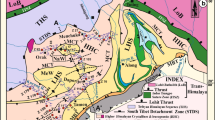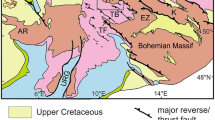Abstract
Apatite fission-track analyses were carried out on outcrop and core samples from the Rhenish massif and the Carboniferous Ruhr Basin/Germany in order to study the late- and post-Variscan thermal and exhumation history. Apatite fission-track ages range from 291±15 Ma (lower Permian) to 136±7 Ma (lower Cretaceous) and mean track lengths vary between 11.6 μm and 13.9 μm, mostly displaying unimodal distributions with narrow standard deviations. All apatite fission-track ages are younger than the corresponding sample stratigraphic age, indicating substantial post-depositional annealing of the apatite fission-tracks. This agrees with results from maturity modelling, which indicates 3500–7000 m eroded Devonian and Carboniferous sedimentary cover. Numerical modelling of apatite fission-track data predicts onset of exhumation and cooling not earlier than 320 Ma in the Rhenish massif and 300 Ma in the Ruhr Basin, generally followed by late Carboniferous–Triassic cooling to below 50–60°C. Rapid late Variscan cooling was followed by moderate Mesozoic cooling rates of 0.1–0.2°C/Ma, converting into denudation rates of <1 mm/a (assuming a stable geothermal gradient of 30°C/km). Modelling results also give evidence for some late Triassic and early Jurassic heating and/or burial, which is supported by sedimentary rocks of the same age preserved at the rim of the lower Rhine Basin and in the subsurface of the Central and Northern Ruhr Basin. Cenozoic exhumation and cooling of the Rhenish massif is interpreted as an isostatic response to former erosion and major base-level fall caused by the subsidence in the lower Rhine Basin.
Access this article
We’re sorry, something doesn't seem to be working properly.
Please try refreshing the page. If that doesn't work, please contact support so we can address the problem.





Similar content being viewed by others
References
Ahrendt H, Clauer N, Hunziker JC, Weber K (1983) Migration of folding and metamorphism in the Rheinisches Schiefergebirge deduced from K–Ar and Rb–Sr age determinations. In: Martin H, Eder FW (eds) Intracontinental fold belts: case studies in the Variscan belt of Europe and the Damara belt, Namibia. Springer, Berlin, Heidelberg, New York, pp 323–338
Barbarand J, Carter A, Wood I, Hurford AJ (2003b) Compositional and structural control of fission-track annealing in apatite. Chem Geol 198:77–106
Barbarand J, Carter A, Hurford T, Wood, I (2003a) Compositional and structural control of fission-track annealing in apatite. Chem Geol 198:107–137
Brix M (2002) Thermal history of Palaeozoic rocks in the Meuse Valley between Charleville-Méziéres and Namur assessed from zircon fission track data. Geol. Belgica Intern. Meeting, Aardk. Mededel., 2002, XX, 000-000: 1–3
Büker C (1996) Absenkungs-, Erosions- und Wärmeflussgeschichte des Ruhrbeckens und des Rechtsrheinischen Schiefergebirges. Diss Univ Bochum, 212 S
Büker C, Carpitella F, Littke R, Welte D-H (1996) Burial and thermal history of Carboniferous sediments in Well Floverich 2E-1 (Aachen-Erkelenz coal district, Germany). Zentralblatt für Geologie und Paläontologie, Teil I: Allgemeine, Angewandte, Regionale und Historische Geologie 11–12:1261–1273
Donelick RA, Ketcham RA, Carlson WD (1999) Variability of apatite fission-track annealing kinetics: II. Crystallographic orientation effects. Am Mineralogist 84:1224–1234
Drozdzewski G (1993) The Ruhr coal basin (Germany): structural evolution of an autochthonous foreland basin. Int J Geol 23:231–250
Fielitz W, Mansy JL (1999) Pre- and synorogenic burial metamorphism in the Ardenne and neighboring areas (Rhenohercynian zone, central European Variscides). Tectonophysics 309:227–256
Franke W (2000) The mid-European segment of the Variscides: tectonostratigraphic units, terrane boundaries and plate tectonic evolution. In: Franke W, Haak V, Oncken O, Tanner D (eds) Orogenic Processes: quantification and modelling in the Variscan Belt. The Geol Soc, London, pp 35–61
Galbraith RF, Laslett GM (1990) Statistical models for mixed fission-track ages. Nucl tracks radiat measure 21:459–470
Galbraith RF, Laslett GM (1993) Statistical models for mixed fission-track ages. Nucl tracks radiat measure 21:459–470
Gallagher K (1995) Evolving temperature histories from apatite fission-track data. Earth Planet Sci Lett 136:421–435
Garver J (2002) Metamictisation of natural zircon: accumulation versus thermal annealing of radioactivity-induced damage. Contrib Miner Petrol 143:756–757
Glasmacher U, Zentilli M, Grist AM (1998) Apatite fission-track thermochronology of paleozoic sandstones and the Hill-Intrusion, Northern Linksrheinisches Schiefergebirge, Germany. In: Van den Haute P, De Corte F (eds) Advances in fission-track geochronology Solid Earth Sciences Library vol 10. Kluwer, Dordrecht pp 151–172
Gleadow AJW, Duddy LR, Green PF, Lovering JF (1986) Confined fission-track lengts in apatite: a diagnostic tool for thermal history analysis. Contr Miner Petrol 94:405–415
Glennie KW (2001) Exploration activities in the Netherlands and North–West Europe since Groningen. Geol Mijnbouw 80:71–84
Green PF, Duddy IR, Laslett GM, Hegarty KA, Gleadow AJW, Lovering JF (1989) Thermal annealing of fission-tracks in apatite 4: quantitative modelling techniques and extension to geological timescales. Chem Geol (Isot Geosci Sect) 79:155–182
Hagedorn B (1992) (U+Th)/He-, K/Ar- und Rb/Sr-Chronologie von Hämatit und Adular hydrothermaler Lagerstätten des Harzes. Diss Univ Heidelberg
Harland et al (1989) A geologic time table. Camebridge University Press, London
Hertle M, Littke R (2000) Coalification pattern and thermal modelling of the Permo-Carboniferous Saar Basin (SW-Germany). Intern J Coal Geol 42:273–296
Hurford AJ (1990) Standardization of fission-track dating calibration: recommendation by the Fission-track Working Group of the I.U.G.S. Subcommission on Geochronology. Chem Geol (Isot Geosci Sect) 80:171–178
Hurford AJ, Green PF (1983) The zeta age calibration of fission-track dating. Isot Geosci 1:285–317
Jenkin GRT, Craw D, Fallick AE (1994) Stable isotopic and fluid inclusion evidence for meteoric fluid penetration into an active mountain belt; Alpine Schist, New Zealand. J Metamorphic Geol 12(4):429–444
Karg H (1998) Numerische Simulation der thermischen Geschichte, Subsidenz und Erosion des westlichen Rechtsrheinischen Schiefergebirges, des Ruhrbeckens und der Niederrheinischen Bucht. Berichte des Forschungszentrums Jülich 3618
Ketcham RA, Donelick WA, Carlson WD (1999) Variability of apatite fission-track annealing kinetics: III Extrapolation to geological time scales. Am Mineralogist 84:1235–1255
Kramm U, Buhl D, Chemychev IV (1985) Caledonian or Variscan Metamorphism in the Venn-Stavelot massif, Ardennes? Arguments from a K–Ar and Rb–Sr Study. N J Geol Paläont Abh 171:339–349
Laslett GM, Galbraith RF (1996) Statistical modelling of thermal annealing of fission-tracks in apatite. Geochim Cosmochim Acta 60:5117–5131
Littke R, Büker C, Lueckge A, Sachsenhofer RF, Welte DH (1994) A new evaluation of palaeo-heat flows and eroded thicknesses for the Carboniferous Ruhr basin, western Germany. Int J Geol 26(3–4):155–183
Littke R, Büker C, Hertle M, Karg H, Stroetmann-Heinen V, Oncken O (2000) Heat flow evolution, subsidence and erosion in the Rheno-Hercynian ororgenic wedge of central Europe. In: Franke W, Haak V, Oncken O, Tanner D (eds) Orogenic Processes: Quantification and Modelling in the Variscan Belt. Geol Soc Lond Spec Publ 179:231–255
Lommerzheim AJ (1994) Die Genese und Migration der Erdgase im Muensterlaender Becken (Formation and migration of natural gas in the Münsterland Basin). Fortschritte in der Geologie von Rheinland und Westfalen 38:308–348
Lüders V, Gerler J, Hein UF, Reutel C (1993) Chemical and thermal development of ore-forming solutions in the Harz Mountains: A summary of fluid inclusion studies. In: Möller P, Lüders V (eds) Formation of of hydrothermal vein deposits—a case study of the Pb–Zn, barite and fluorite deposits of the Harz Mountains. Monograph Series on Mineral Deposits, 30:117–132
McKerrow WS, MacNiocaill C, Ahlberg P, Clayton G, Cleal CJ, Eager RMC (2000) The late Palaeozoic relations between Gondwana and Laurussia. In: Franke W, Haak V, Oncken O, Tanner D (eds) Orogenic Processes: Quantification and Modelling in the Variscan belt. Geol Soc Spec Publ 179:9–20
Murawski H, Albers HJ, Bender P, Bremers HP, Dürr St, Huckriede R, Kauffmann G, Kowalczyk G, Meiburg P, Müller R, Ritzkowski S, Schwab K, Semmel A, Stapf K, Walter R, Winter KP, Zankl H (1983) Regional tectonic setting and geologic structure of the Rhenish massif. In: Plateu Uplift (eds Fuchs K, et al), pp 9–38
Naeser ND, Naeser CW, McCulloch TH (1989) The application of fission-track dating to the depositional and thermal history of rocks in sedimentary basins. In: Naeser ND, McCulloch TH (eds) Thermal histories of sedimentary basins—methods and case histories. Springer, New York, Berlin, Heidelberg, pp 157–180
Nöth S, Karg H, Littke R (2001) Reconstruction of late Paleozoic heat flows and burial histories at the Rhenohercynian-Subvariscan boundary, Germany. Int J Earth Sci 90(2):234–256
Oncken O (1989) Geometrie, Deformationsmechanismen und Kinematik grosser Störungszonen der hohen Kruste (Beispiele Rheinisches Schiefergebirge). Geotekton Forschungen 73:1–215
Oncken O (1991) Aspects of the structural and paleogeothermal evolution of the Rhenish massif. Ann Soc Geol Belg 113:139–159
O’Reilly, Jenkin GRT, Feely M (1997) A fluid inclusion and stable isotope study of 200 Ma of fluid evolution in the Galway Granite, Conemara, Ireland. Contrib Miner Petrol 129:120–142
Patteisky KE, Teichmüller M, Teichmüller R (1962) Das Inkohlungsbild des Steinkohlengebirges an Rhein und Ruhr, dargestellt im Niveau von Flöz Sonnenschein. Fortschr Geol Rheinl u Westf 3:687–700
Piqué A, Huon S, Clauer N (1984) La schistosité hercynienne et le metamorphisme associé dans la Valleé de la Meuse, entre Charleville-Mézières et Namur (Ardennes franco-belges). Bull Soc Belge Geol 93:70–77
Tait J, Schätz M, Bachtadse V, Soffel H (2000) Palaeomagnetism and Palaeozoic palaeogeography of Gondwana and European terranes. In: Franke W, Haak V, Oncken O, Tanner D (eds) Orogenic Processes: Quantification and Modelling in the Variscan belt. Geol Soc Spec Publ 179:21–34
Tschernoster R, Glasmacher U, Spaeth G, Clauer N (1995) K-Ar-Datierungen zur Abkühlungsgeschichte ausgewählter Magmatite und Metapelite aus dem Stavelot-Venn Massiv. In: Walter R, Glasmacher U, Wolf M (eds) KW-Relevante Eigenschaften potentieller Mutter- und Speichergesteine am Nordrand des Linksrheinischen Schiefergebirges IV:1–20
Utescher T, Mosbrugger V, Ashraf AR (2002) Facies and paleogeography of the Tertiary lower Rhine Basin—sedimentary versus climatic control. Neth J Geosci/Geol Mijnbouw 81(2):185–191
Vercoutere C, van den Haute P (1993) Post-Palaeozoic cooling uplift of the Brabant massif as revealed by apatite fission-track analysis. Geol Mag 130(5):639–646
Verweij JM, Simmelink HJ, van Balen RT, David P (2003) History of petroleum systems in the southern part of the Broad Fourteens Basin. Neth J Geosci 82(1):71–90
Walter R (1995) Geologie von Mitteleuropa. Schweitzerbart, Stuttgart, p 561
Acknowledgements
Financial support by the German Research Foundation (DFG) is gratefully acknowledged. This study was part of the DFG priority programme, “Simulation orogener Prozesse am Beispiel der Varisziden”. We thank F. Hansen and K. Poddig for mineral separation and sample preparation for fission-track analysis. The comments of Dr. Stuart Thomson and an anonymous reviewer helped to improve the manuscript considerably.
Author information
Authors and Affiliations
Corresponding author
Rights and permissions
About this article
Cite this article
Karg, H., Carter, A., Brix, M.R. et al. Late- and post-Variscan cooling and exhumation history of the northern Rhenish massif and the southern Ruhr Basin: new constraints from fission-track analysis. Int J Earth Sci (Geol Rundsch) 94, 180–192 (2005). https://doi.org/10.1007/s00531-005-0467-2
Received:
Accepted:
Published:
Issue Date:
DOI: https://doi.org/10.1007/s00531-005-0467-2




